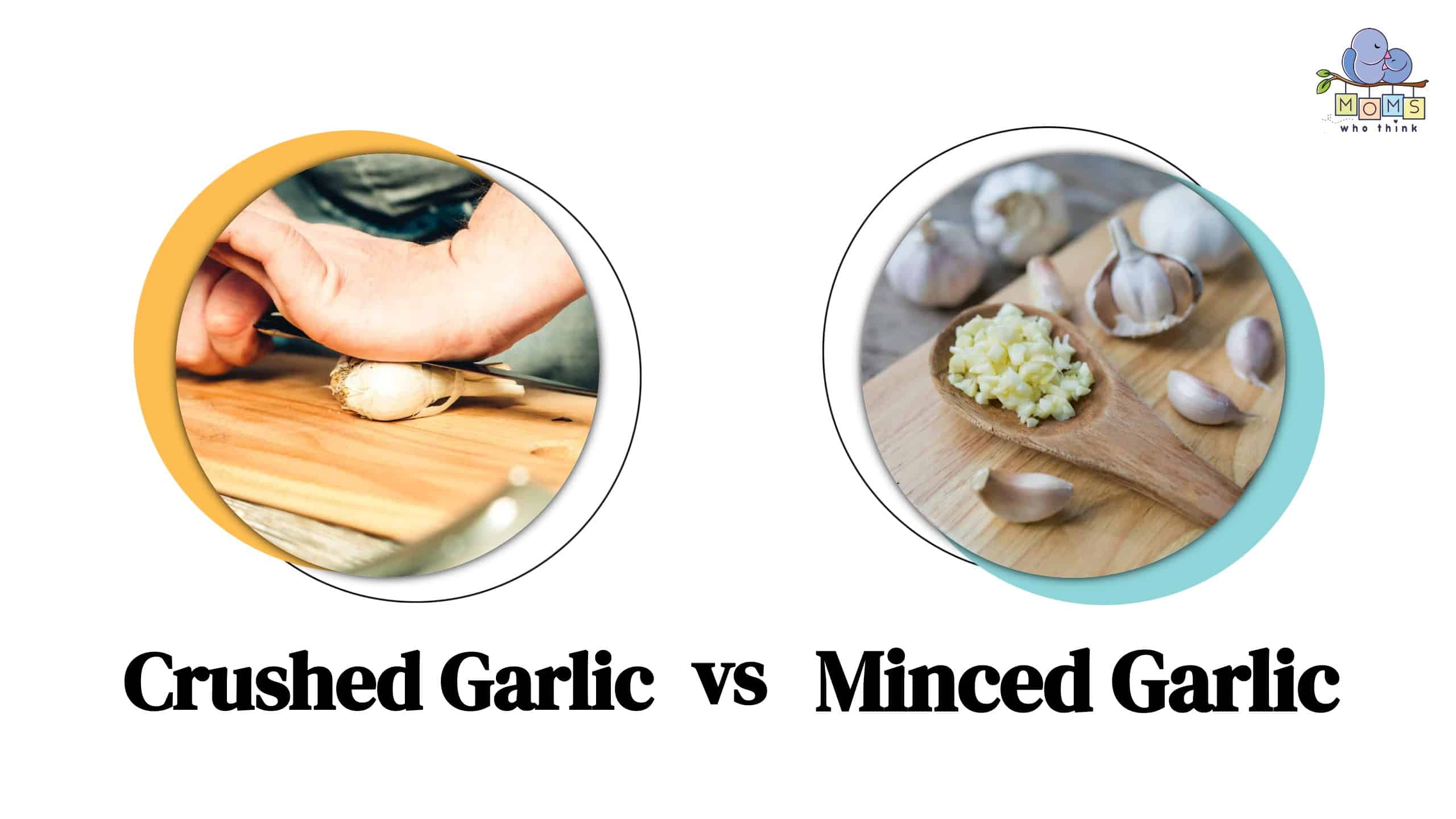Garlic is a powerful and delicious ingredient that is often in many recipes. It releases an intense and sometimes sweet flavor that can bring uniqueness to any dish. There are many ways to prepare garlic. Two of the most popular ways include crushing and mincing. However, what is the difference between crushed garlic and minced garlic? It all comes down to the preparation method. It is within the preparation method that gives the ability to control the flavor and aroma. Crushed garlic has a more mild and subtle flavor. Minced garlic, on the other hand, has a more in-your-face taste. The intense flavor of minced garlic is powerful enough to taste throughout the dish. However, crushed garlic will have a subtle taste distributed throughout the dish.
If you like the strong flavor of garlic, minced garlic is a great option. Crushed garlic is an excellent alternative for those who may enjoy a subtle flavor.
Crushed Garlic vs. Minced Garlic: What are the Main Differences?
The main difference between minced and crushed garlic is in the preparation method.
Minced garlic involves chopping the garlic into very fine grains. Crushed garlic is simply crushing the garlic very gently, usually with a fork or a knife.
Garlic has a sulfur liquid that is released with every cut or dice. The liquid carries a garlicky flavor and aroma. Thus, the more you cut, crush, and dice the garlic, the stronger the flavor and smell will be. This is because more of the liquid is released with every separation of the outer layer.
- The must-have convenient reference guide for every home cook!
- Includes more than 8,000 substitutions for ingredients, cookware, and techniques.
- Save time and money on by avoiding trips to grab that "missing" ingredient you don't really need.
The flavor of minced and crushed garlic is also different. Minced garlic has a more robust, more immediate flavor. Crushed garlic is subtle yet still garlicky.
You can control the flavor of your garlic by how finely you chop it up. You can even take it back a little bit more and simply use the whole garlic clove without chopping it up while cooking. One would think a larger garlic clove would give a stronger taste, yet the opposite is actually true. Although the texture and bite of the garlic clove would not be as fine as minced or crushed garlic, the flavor will be milder.
Anatomy of Garlic
Let's take a look at the anatomy of garlic. Garlic is part of the Amaryllis family. The scientific name for garlic is Amaryllidaceae. It is a perennial plant whose bulb grows undergrown.
The green stalk grows from the bulb above ground, and some species of garlic will have a flower on the stalk.
The garlic plant is in the same family group as onions, chives, and leeks.
The basic types of garlic are hardneck and softneck. However, on all bulbs, you will find the same anatomy. The head of garlic encases all the cloves. Around the head of garlic, you will find a papery wrapper. As you peel it away, the cloves are easier to peel off. Underneath the clove skin, you will finally have your garlic clove.
What is the Difference Between a Clove and a Bulb?
There is a difference between the garlic bulb and garlic clove. When a recipe calls for a head of garlic, it is saying to use the entire bulb. On the other hand, when a recipe calls for a clove of garlic, it refers to the small pieces found inside the garlic head. These pieces can be eaten while whole, crushed up, diced, finely minced, and more. Experiment with various ways of preparing the garlic. In doing so, you will find the right amount of flavor and spice that you love!
Inside each garlic bulb, there are tiny cells. They have a sulfur-based liquid. The more you chop, crush, or slice the garlic, the stronger the flavor and smell of the released garlic. That is because the barrier on each cell breaks, releasing more sulfur liquid. It is within this liquid that the flavor of garlic is found. A stronger flavor and aroma will be presented when the garlic is minced. The flavor and aroma will be less if the garlic is merely whole or crushed.
What is Crushed Garlic?
Crushed garlic refers to the method of preparing garlic. One of the most popular ways to crush garlic is to use a fork to smash the garlic clove once gently.
Cushing garlic releases a mild flavor, adding a garlicky taste to your dish. The cells are not broken up repeatedly during crushing garlic. This means the flavor is not quite as intense as minced garlic.
Some prefer crushed garlic over minced garlic because the flavor is not nearly as strong. With crushed garlic, the texture will be smooth and it will easily melt into the dish.
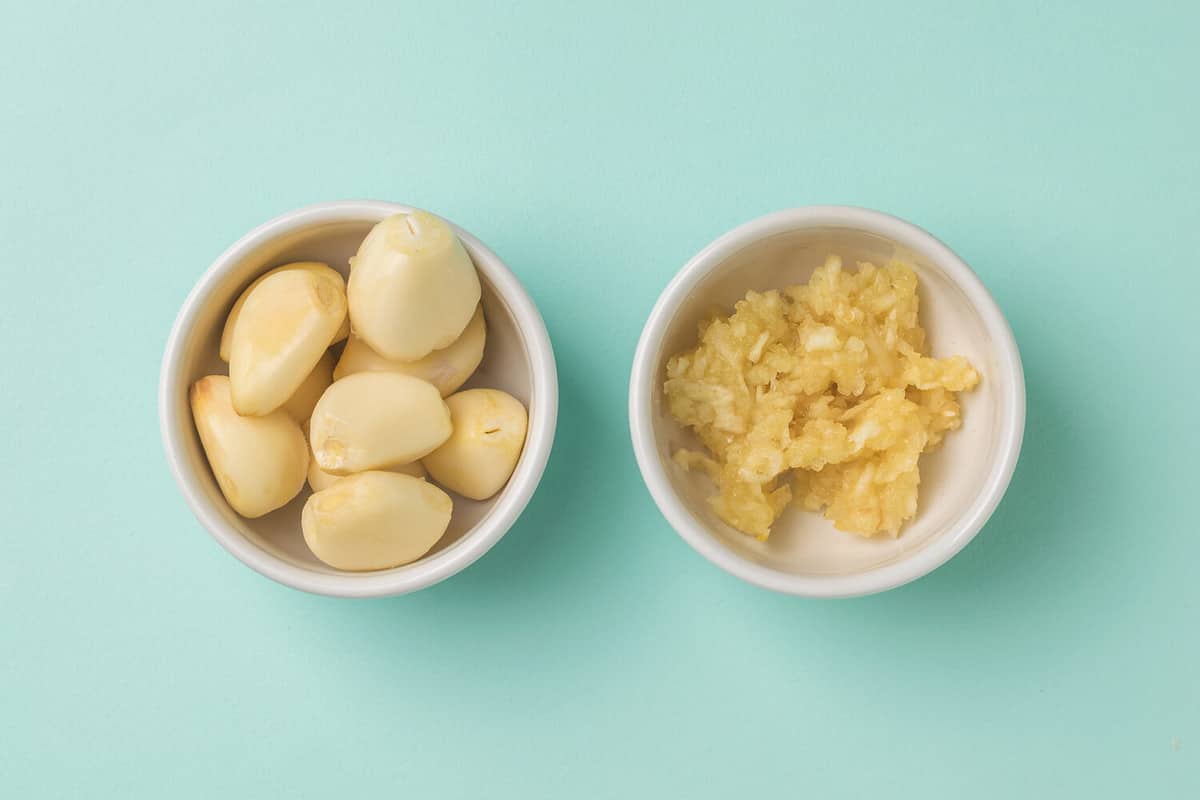
©VLADIMIR VK/Shutterstock.com
What is Minced Garlic?
Minced garlic is very tiny pieces of garlic. The texture is very fine and coarse. Finally, minced garlic will emit the most potent flavor and aroma. However, because of its delicate nature, it can burn more easily.
The taste of finely minced garlic can be sweet, yet it also carries a strong garlicky taste. More sulfur-liquid is released when garlic undergoes cutting, smashing, and crushing.
Minced garlic will spread throughout your dish and may melt into the sauce. However, the flavor will remain. This is one of the reasons why it is so prominent in many recipes!
Garlic can be minced by hand cutting or using a bladed mincing tool. It is also premade at the grocery store. It is important to remember that the longer the garlic sits out, the more potent the flavor and aroma will be. For a mild flavor, use fresh garlic. For a strong flavor, canned garlic is great. Don't be afraid to try different methods to change the flavor!
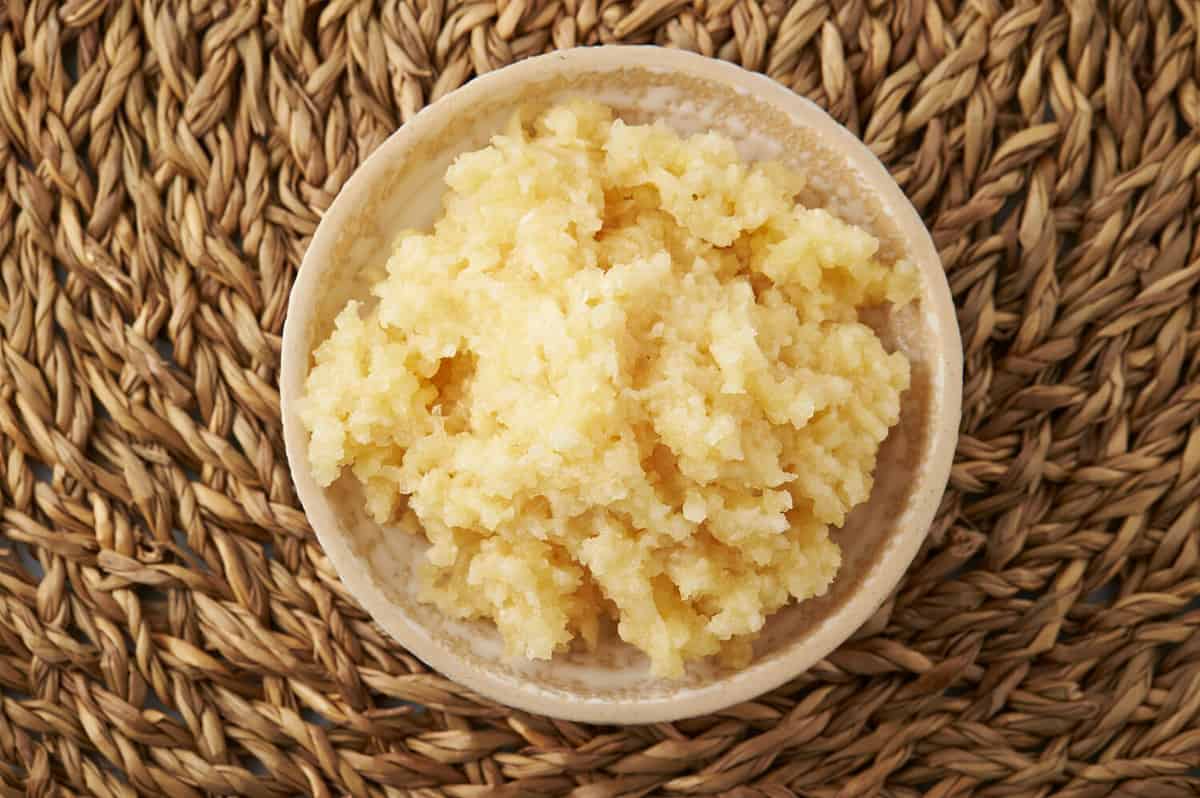
©mnimage/Shutterstock.com
Health Benefits of Garlic
Garlic offers some health benefits; let's look at a few!
It has only a tiny amount of calories but has excellent nutrition. For starters, it has Vitamin B6, vitamin C, Fiber, and Manganese. Garlic also has protein.
Another health benefit is its ability to protect from illnesses. This is because garlic increases the strength of the immune system.
- The must-have convenient reference guide for every home cook!
- Includes more than 8,000 substitutions for ingredients, cookware, and techniques.
- Save time and money on by avoiding trips to grab that "missing" ingredient you don't really need.
Garlic also lowers the LDL cholesterol, which is not great for your heart! The lower your LDL cholesterol, the better.
Garlic also has antioxidants in it. This benefits your cells, and antioxidants can fight against aging.
These are a few of the incredible benefits that garlic has! Take a look below at the nutritional value comparison chart.
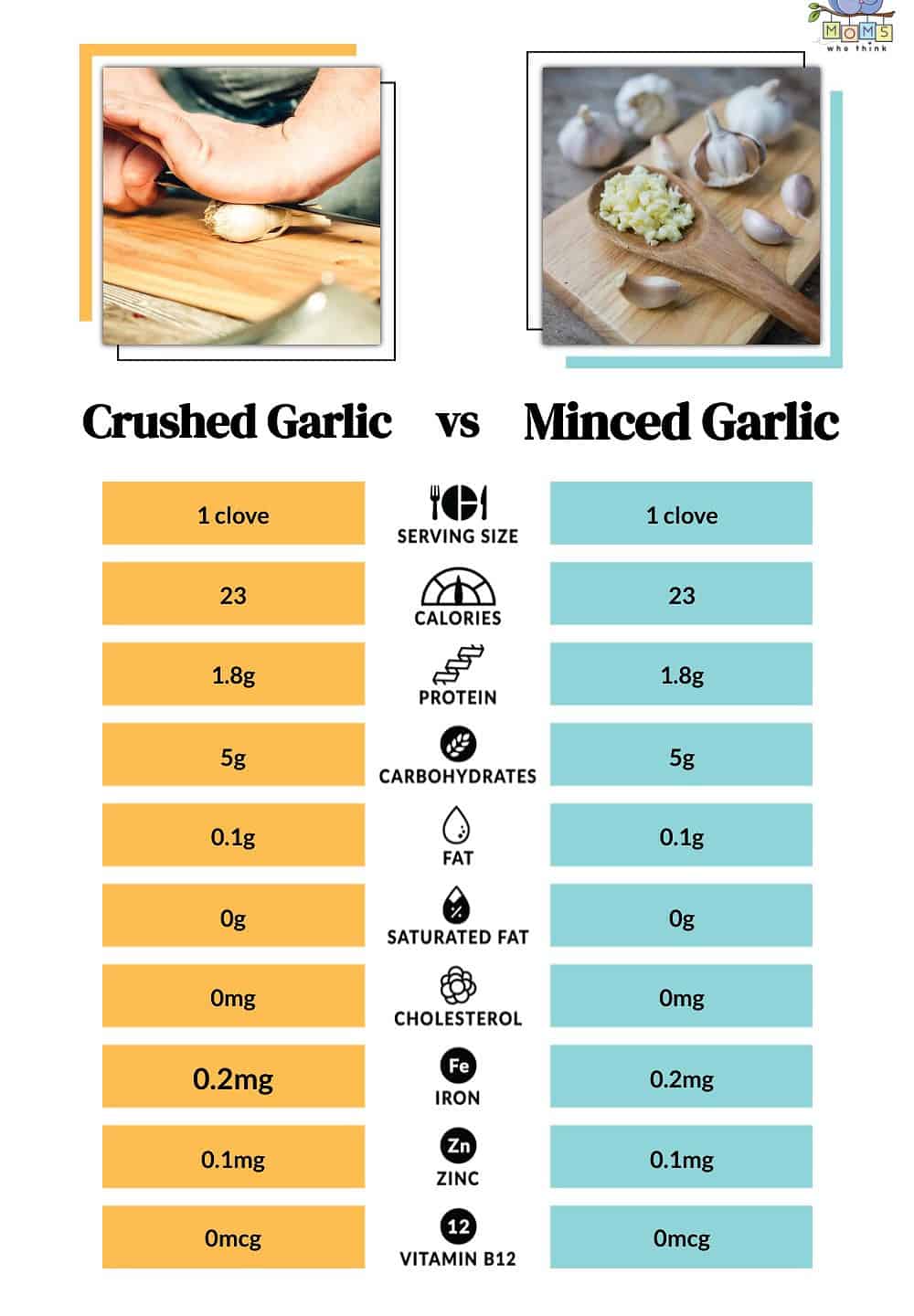
In Conclusion
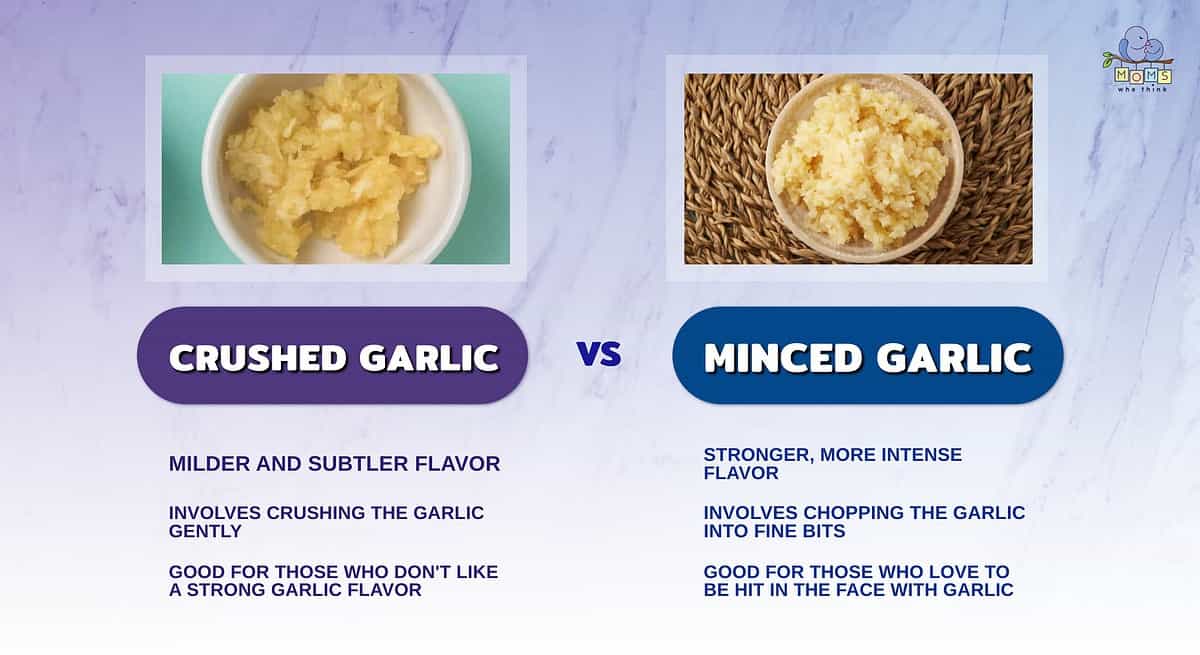
- Crushed garlic has a milder, subtler flavor in comparison to minced garlic.
- To make minced garlic, you need to chop the garlic into fine bits. Crushed garlic, as the name implies, involves gently crushing the garlic.
- Because crushed garlic has a subtler flavor, it's great for those who don't want an overpowering garlic taste in their dish. For those who adore garlic, minced garlic is a great option.
Garlic is a popular ingredient that many use in their recipes. It has a solid and intense flavor. However, did you know you could control the intensity of the flavor by how finely you chop the garlic? This is where crushed and minced garlic differ. Minced garlic produces a strong and immediate flavor. At the same time, crushed garlic is more subtle and mild yet still sweet and garlicky. Do you enjoy the mild hint of garlic or the in-your-face intensity? Regardless, there are many different ways to enjoy the fantastic flavor of garlic!
If you're unsure of what to make for dinner next week, check out this garlic pork stir-fry:
PrintGarlic Pork Stir-Fry
- Yield: 4 entrees, 4-6 servings each 1x
Ingredients
1 pork loin (about 8 pounds; do not use tied pork loin roast)
1½ cups soy sauce
½ cup white wine vinegar
2 tablespoons sugar
8 teaspoons minced garlic (about 24 cloves)
1 teaspoon crushed red pepper
4 large onions, cut into 2-inch pieces
4 large green bell peppers, cut into 2-inch pieces
Supplies:
4 one-gallon freezer bags, labeled
12 one-quart freezer bags
On Hand for each entrée:
2 teaspoons vegetable oil
½ cup cornstarch
Instructions
1. Rinse and trim pork loin as desired. Cut pork into bite-size cubes; divide evenly among four or the 1-quart bags. Seal.
2. Whisk together soy sauce, vinegar, and sugar in a medium bowl. Divide the marinade evenly among four 1-quart bags. Into each bag of sauce measure 2 teaspoons garlic and ¼ teaspoon crushed red pepper. Seal.
3. Divide onions and bell peppers evenly among the remaining 1-quart bags. Seal.
4. Into each of the 1-gallon bags, place a bag of pork, a bag of sauce, and a bag of peppers and onions. Seal and freeze.
To Serve:
1. Completely thaw one entrée in the refrigerator.
2. Pour off and discard any accumulated liquid from the bag of pork. Add ½ cup cornstarch; seal bag and shake to coat the meat.
3. Heat oil in a large skillet over medium-high heat. Add pork and stir-fry until thoroughly cooked, about 10 minutes. Add vegetables and sauce. Stir-fry just until vegetables are tender crisp. Serve over your choice of rice.
Notes
Freeze up to: 4 months
Comparison Posts
- Onion Salt vs. Onion Powder: Is There a Difference?
- Garlic Salt vs. Garlic Powder: The Key Difference Between Them
- Sambal Oelek vs. Chili Garlic Sauce: What's the Difference?
- House Salad vs Caesar Salad: A Comparison of Their Ingredients and Nutritional Benefits
- Scorpion Pepper vs. Carolina Reaper: Heat Units, Flavor Differences, And Popular Uses!
